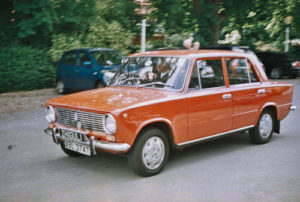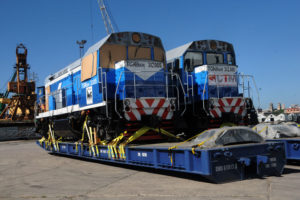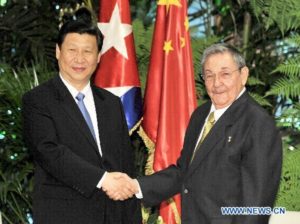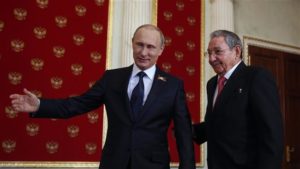Russia will send a package of 320 Vesta la Vesta to the island before the end of the year as part of the interest of the Kremlin to strengthen its presence in the Cuban market.
The Izhevsk automobile factory, which is responsible for supplying the islands with the island, has produced more than 28 million copies of this model alone, distributed especially in the European markets.
The modern ladas will be used in the taxi service, as CiberCuba announced last September. Mikhail Ryabov, CEO of the company, emphasized the quality of this vehicle and described the links with Cuba as promising.
Cubans are very familiar with this type of car because they went along with Moscovich and Polski, the main models of cars that came to the island from the former Soviet Union. The majority of these will be destined mainly to tourism.
They hope that the next shipments will be incorporated into the public transport circuit to alleviate the difficult situation the country is experiencing in that sector, an official linked to the Ministry of Transportation told CiberCuba by telephone.
Currently Cubans who can afford the passage use as taxis the so-called almendrones that cover the main routes of the capital. Hence, perhaps in the future the new Vesta ladas will compete with the old American cars on Cuban streets.
ELECTRIC OMNIBUS BEGINS TO ARRIVE TO CUBA.
Electric bus of type E12, carried by the Chinese company Yutong with the aim of avoiding pollution with gases and saving energy, will circulate in Havana.
The bus, which does not emit any noise, had to be adapted to Cuban conditions, since it worked with 380 volts, while on the Island it works with 110, 220 or 440 volts.
It is expected that it will soon be operational on route 18, from the capital, which begins its journey in the Palatino terminal, in the Cerro municipality, continues through Centro Habana and ends at the La Luz pier in Old Havana.
Yutong started taking buses to Cuba in 2005, with an initial batch of 12 vehicles. Since then, he has sold more than 6,000 units to the island.
NEW RUSSIAN LOCOMOTIVES ARRIVE TO CUBA.
A few days to celebrate the 180th anniversary of the Cuban railway arrived on the island the first seven Russian locomotives of a general contract of 75, the rest will come gradually, reported the UFC today.
In a conversation with Prensa Latina, the deputy director of the Union of Railways of Cuba (UFC), Rolando Navarro, explained that seven of the 15 teams acquired this year arrived, and for the first half of January the entrance to the country is scheduled. of the remaining eight, and in addition, another 28 will come during 2018.
Navarro stressed that the machines that arrived at the port today will be used in the western zone in the transportation of the sugar harvest and cargo, both priorities of the country due to the need to move both the production, fuel, containers or food.
Cuba already has experience in working with the equipment produced in this factory, which are also used in the sugar harvest, and are of the types TGM 8 and TGM 4, he said, adding that the former have been on the island for some twenty years.
The new locomotives differ from the previous ones due to their modernizations, they have more power, the equipment is hydraulic diesel similar to the previous one, they have a new compressor, the engine is more powerful, and the transmission and control signaling systems have been improved. And control.
Now the second stage of the training, he said, which will be held in Cuba at the Narrow Workshop in the Mariel Special Development Zone, together with Russian specialists to work on the start-up of these locomotives.
Russia and China are consolidated as key players in all areas of economic and social development of Cuba until the year 2030, said Deputy Minister of Foreign Trade and Foreign Investment, Ileana Núñez.
“Russia is one of the main trading partners of Cuba, one of the first five in the world and the second in Europe,” Núñez told Sputnik news agency.
Russia and China will also acquire greater prominence as strategic partners “because they will participate in the economic and social development of Cuba in the plan drawn up to 2030”.
RUSIA Y CHINA COMIENZAN A PARTICIPAR EN EL “TOTAL DESARROLLO ECONÓMICO” DE CUBA, SUSTITUYENDO A EEUU.
Rusia enviará un paquete de 320 ladas Vesta a la Isla antes de fin de año como parte del interés del Kremlin por afianzar su presencia en el mercado cubano.
La fábrica de automóviles de Izhevsk, la encargada de suministrar los ladas a la Isla, ha producido solo en este año más de 28 millones de copias de ese modelo que se distribuyen especialmente en los mercados de Europa.
Los modernos ladas serán utilizados en el servicio de taxi, como anunció CiberCuba el pasado mes de septiembre. Mikhail Ryabov, director general de la compañía, enfatizó la calidad de este vehículo y calificó como prometedores los vínculos con Cuba,
Los cubanos están muy familiarizados con este tipo de automóviles pues fueron junto al Moscovich y Polski, los principales modelos de carros que llegaron a la Isla provenientes de la antigua Unión Soviética. La mayoría de estos ladas serán destinados principalmente al turismo.
Esperan que los próximos envíos, estos se incorporen al circuitito del transporte público para aliviar la difícil situación que vive el país en ese sector, dijo a CiberCuba vía telefónica un funcionario vinculado al Ministerio de Transporte.
Actualmente los cubanos que puedan pagar el pasaje utilizan como taxis los llamados almendrones que cubren las principales rutas de la capital. De ahí que quizás en un futuro los nuevos ladas Vesta hagan la competencia a los viejos carros americanos en las calles cubanas.
OMNIBUS ELECTRICOS COMIENZAN A LLEGAR A CUBA.
Omnibus eléctrico de tipo E12, llevados por la empresa China Yutong con el objetivo de evitar la contaminación con gases y ahorrar energía, circularán por La Habana.
El autobús, que no emite ruido alguno, tuvo que ser adaptado a las condiciones cubanas, ya que funcionaba con 380 volts, mientras que en la Isla se trabaja con 110, 220 o 440 volts.
Se prevé que próximamente entre en funcionamiento en la ruta 18, de la capital, que inicia su recorrido en la terminal Palatino, en el municipio del Cerro, continúa por Centro Habana y termina en el muelle La Luz, en La Habana Vieja.
Yutong comenzó a llevar ómnibus a Cuba en 2005, con un lote inicial de 12 vehículos. Desde ese entonces, ha vendido a la Isla más de 6.000 unidades.
NUEVAS LOCOMOTORAS RUSAS LLEGAN A CUBA.
A pocos días de festejar el 180 aniversario del ferrocarril cubano arribaron a la isla las primeras siete locomotoras rusas de una contratación general de 75, las restantes llegaran paulatinamente, informó hoy la UFC.
En conversación con Prensa Latina el director adjunto de la Unión de Ferrocarriles de Cuba (UFC), Rolando Navarro, explicó que en esta jornada llegaron siete de los 15 equipos adquiridos este año, y para la primera quincena de enero está prevista la entrada al país de los ocho restantes, y además, vendrán otras 28 durante 2018.
Navarro destacó que las máquinas que hoy arribaron puerto se utilizarán en la zona occidental en las labores de transportación de la zafra azucarera y de carga, ambas prioridades del país debido a la necesidad de trasladar tanto las producciones, como el combustible, contenedores o alimentos.
Cuba ya posee experiencia en el trabajo con los equipos producidos en esta fábrica, los cuales se emplean igualmente en la zafra azucarera, y son de los tipos TGM 8 y TGM 4, señaló y agregó que las primeras se encuentran en la isla desde hace unos veinte años.
Las nuevas locomotoras se diferencian de las anteriores debido a sus modernizaciones, poseen mayor potencia, el equipamiento es diesel hidráulico similar al anterior, tienen un compresor nuevo, el motor es más potente, y ha sido mejorada la transmisión y los sistemas de señalización de mando y control.
Ahora resta la segunda etapa del entrenamiento, dijo, el cual se realizará en Cuba en el Taller de Angosta en la Zona Especial de Desarrollo Mariel, de conjunto con especialistas rusos para trabajar en la puesta en marcha de esas locomotoras.
Rusia y China se consolidan como actores claves en todas las esferas del desarrollo económico y social de Cuba hasta el año 2030, afirmó la viceministra de Comercio Exterior e Inversión Extranjera, Ileana Núñez.
“Rusia es uno de los principales socios comerciales de Cuba, uno de los primeros cinco del mundo y el segundo en Europa”, dijo Núñez a la agencia Sputnik
Rusia y China también adquirirán mayor protagonismo como socios estratégicos “porque va a participar de todo el desarrollo económico y social de Cuba en el plan trazado hasta 2030”.
Agencies/CiberCuba/Sputnik/Various/Alberto Fiallo/Internet Photos/ Arnoldo Varona/ TheCubanHistory.com
THE CUBAN HISTORY, HOLLYWOOD.












